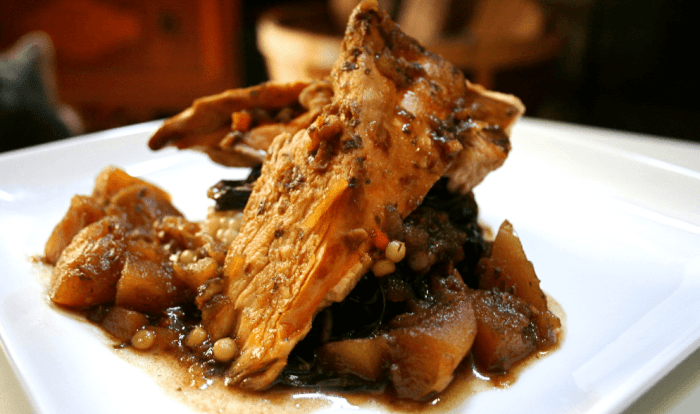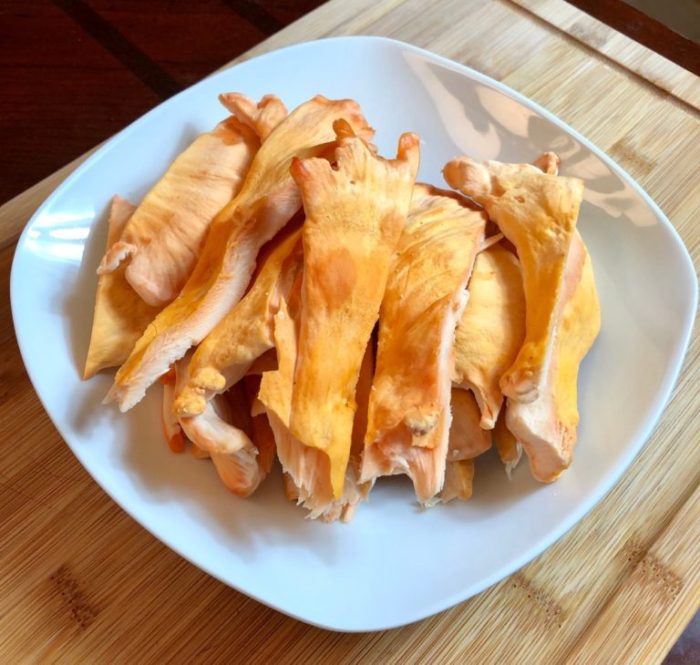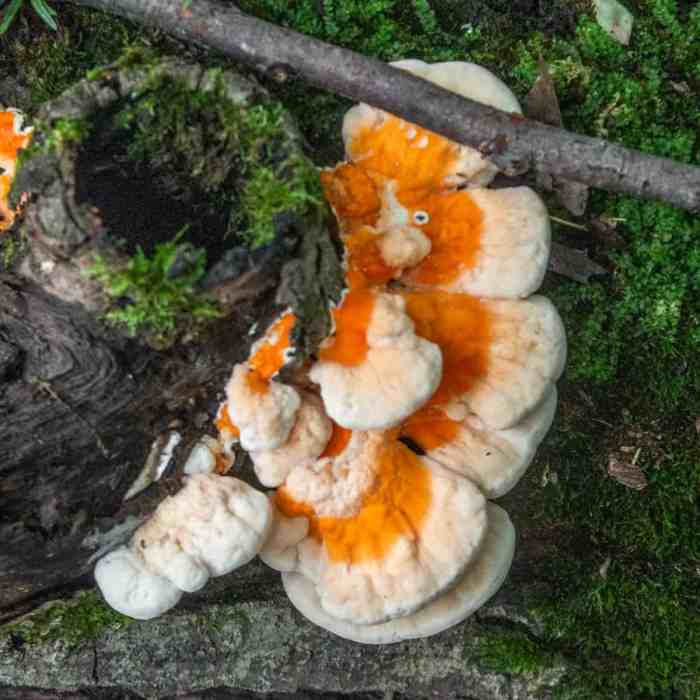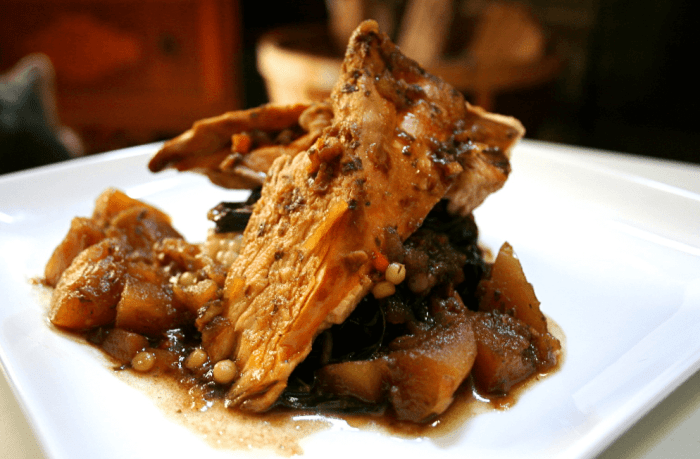
Discover the tantalizing world of chicken of the woods recipe, where culinary adventure meets nutritional delight. These vibrant mushrooms, boasting a texture reminiscent of tender chicken, offer a unique and versatile ingredient to elevate any dish.
From hearty soups and savory stews to tantalizing stir-fries and meatless mains, this comprehensive guide will unveil the culinary secrets of chicken of the woods, guiding you through foraging, identification, and preparation techniques. Dive in and let the umami-rich flavors of these woodland treasures ignite your taste buds!
Recipe Variations
Chicken of the woods mushrooms are a versatile ingredient that can be used in a variety of recipes. Their unique flavor and texture make them a great addition to appetizers, main courses, soups, and stews.
When cooking with chicken of the woods mushrooms, it is important to clean them thoroughly. To do this, simply brush off any dirt or debris and then rinse them under cold water. You can then cut the mushrooms into any desired shape or size.
Here are a few of our favorite chicken of the woods mushroom recipes:
Appetizers
- Chicken of the Woods Mushroom Bruschetta: This simple appetizer is made with chicken of the woods mushrooms, garlic, olive oil, and balsamic vinegar. It’s a great way to start a meal or serve as a snack.
- Chicken of the Woods Mushroom Soup: This creamy soup is made with chicken of the woods mushrooms, onions, celery, and carrots. It’s a hearty and flavorful soup that’s perfect for a cold day.
Main Courses
- Chicken of the Woods Mushroom Tacos: These tacos are made with chicken of the woods mushrooms, onions, peppers, and your favorite taco toppings. They’re a delicious and easy way to enjoy chicken of the woods mushrooms.
- Chicken of the Woods Mushroom Stir-Fry: This stir-fry is made with chicken of the woods mushrooms, vegetables, and your favorite stir-fry sauce. It’s a quick and easy meal that’s packed with flavor.
Soups and Stews
- Chicken of the Woods Mushroom Stew: This stew is made with chicken of the woods mushrooms, beef, vegetables, and red wine. It’s a hearty and flavorful stew that’s perfect for a cold day.
- Chicken of the Woods Mushroom and Barley Soup: This soup is made with chicken of the woods mushrooms, barley, vegetables, and chicken broth. It’s a hearty and flavorful soup that’s perfect for a cold day.
Nutritional Value and Health Benefits
Chicken of the woods mushrooms are packed with an impressive nutritional profile, making them a valuable addition to a healthy diet.
They are an excellent source of protein, providing a substantial amount of essential amino acids. They are also rich in dietary fiber, which promotes digestive health and satiety. Additionally, they contain a variety of vitamins, including vitamin D, B vitamins, and vitamin C, which contribute to overall well-being.
If you’re a fan of mushroom hunting, you’ll definitely want to check out the chicken of the woods recipe . This tasty fungus is a great source of protein and can be used in a variety of dishes. The recipe is easy to follow and the results are delicious.
Antioxidant and Anti-inflammatory Properties, Chicken of the woods recipe
Chicken of the woods mushrooms are also recognized for their potential health benefits. They are rich in antioxidants, which help protect cells from damage caused by free radicals. Studies have shown that these antioxidants may play a role in reducing the risk of chronic diseases, such as cancer and heart disease.
Furthermore, chicken of the woods mushrooms have demonstrated anti-inflammatory properties. Inflammation is a major factor in many chronic diseases, and consuming these mushrooms may help reduce inflammation throughout the body.
Potential Risks and Precautions
While chicken of the woods mushrooms are generally safe to consume, there are some potential risks and precautions to consider.
- Misidentification:It is crucial to ensure accurate identification before consuming chicken of the woods mushrooms, as some similar-looking mushrooms can be toxic.
- Digestive Issues:Consuming large amounts of chicken of the woods mushrooms may cause digestive discomfort in some individuals.
- Allergic Reactions:Although rare, some people may be allergic to chicken of the woods mushrooms.
Foraging and Identification

Embarking on a foraging expedition for chicken of the woods mushrooms is an enriching experience that connects you with nature’s hidden treasures. To ensure a successful and responsible foraging adventure, understanding the typical habitat, appearance, and potential look-alikes of these fungi is crucial.
Chicken of the woods mushrooms thrive in deciduous forests, particularly around the base of oak trees. They typically emerge in late summer and early fall, forming vibrant orange or yellow clusters that resemble the shape of a chicken’s head or cauliflower.
Identifying Chicken of the Woods
- Size and Shape:Chicken of the woods mushrooms can grow quite large, reaching up to 12 inches in diameter. They have a distinctive fan-shaped or shelf-like appearance with a wavy or lobed margin.
- Color:The color of chicken of the woods mushrooms varies from bright orange to yellow, often with a reddish hue. As they mature, the color may fade slightly.
- Texture:The flesh of chicken of the woods mushrooms is firm and meaty, with a slightly spongy texture. When cooked, it develops a tender and flavorful consistency.
- Gills:On the underside of the mushroom, you will find small, tooth-like gills that extend down the stem. These gills are often white or cream-colored.
- Stem:Chicken of the woods mushrooms typically have a short, thick stem that is often hidden within the cluster. The stem may be white or yellow and may have a velvety texture.
Look-Alikes
While chicken of the woods mushrooms are generally easy to identify, it’s important to be aware of potential look-alikes. One common look-alike is the false chicken of the woods mushroom( Laetiporus sulphureus). This mushroom has a similar appearance but is typically brighter orange and has larger, more widely spaced gills.
Another look-alike is the jack-o’-lantern mushroom( Omphalotus illudens). This mushroom is toxic and has a similar orange color, but it glows in the dark and has gills that run down the entire length of the stem.
Responsible Foraging
When foraging for chicken of the woods mushrooms, it’s essential to practice responsible harvesting techniques to ensure the sustainability of these fungi. Here are some guidelines to follow:
- Only harvest mature mushrooms:Young mushrooms are more vulnerable and should be left to grow. Harvest only mushrooms that are fully developed and have a firm texture.
- Cut, don’t pull:When harvesting chicken of the woods mushrooms, use a sharp knife to cut them at the base of the stem. Avoid pulling them out, as this can damage the mycelium and prevent future growth.
- Leave some behind:It’s important to leave some mushrooms behind for wildlife and to ensure the survival of the species. Avoid harvesting large quantities from a single location.
- Respect the environment:Be mindful of your surroundings and avoid damaging other plants or wildlife. Leave the foraging area as you found it.
Culinary Applications

Chicken of the woods mushrooms offer a versatile culinary experience with their unique flavor and texture. They can be incorporated into various dishes, from hearty soups and stews to stir-fries and even as a meat substitute.
When preparing chicken of the woods mushrooms, it’s important to clean them thoroughly to remove any dirt or debris. Cut them into bite-sized pieces to enhance their flavor absorption. To preserve their delicate texture, avoid overcooking them. Sautéing, grilling, or roasting are recommended cooking methods to bring out their best qualities.
Tips for Enhancing Flavor
- Marinate the mushrooms in a mixture of herbs, spices, and olive oil to infuse them with extra flavor.
- Add them to soups or stews during the last 15 minutes of cooking to prevent them from becoming rubbery.
- When using chicken of the woods as a meat substitute, shred them and season them with your favorite seasonings for a plant-based protein option.
Creative Incorporations
- Incorporate them into pasta dishes for a savory and earthy flavor.
- Add them to omelets or quiches for a boost of protein and nutrition.
- Use them as a topping for pizzas or flatbreads for a unique and flavorful twist.
Cultivation and Preservation

Chicken of the woods mushrooms can be cultivated at home, but the process is not as straightforward as growing other types of mushrooms. The mushrooms require a specific substrate and environmental conditions to thrive.
The most common method for cultivating chicken of the woods mushrooms is to use a sawdust-based substrate. The substrate is prepared by mixing sawdust with a nutrient-rich material, such as wheat bran or soybean meal. The substrate is then inoculated with chicken of the woods mushroom spores or mycelium.
Once the substrate is inoculated, it is placed in a growing container and incubated at a temperature of 70-80 degrees Fahrenheit. The container should be kept humid and well-ventilated. The mushrooms will begin to grow in about 2-3 weeks.
Chicken of the woods mushrooms can also be preserved by drying, freezing, or canning. Drying is the most common method of preservation. The mushrooms are sliced and dried in a food dehydrator or in the sun. Dried mushrooms can be stored in an airtight container for up to a year.
Freezing is another option for preserving chicken of the woods mushrooms. The mushrooms are cleaned and sliced, then frozen in airtight containers. Frozen mushrooms can be stored for up to 6 months.
Craving a unique culinary experience? Try the chicken of the woods recipe . This wild mushroom delicacy boasts a meaty texture and savory flavor that will satisfy your taste buds. Whether you’re an experienced forager or a novice cook, this recipe provides step-by-step instructions to guide you through the process.
Canning is a less common method of preserving chicken of the woods mushrooms. The mushrooms are cooked and then canned in jars. Canned mushrooms can be stored for up to a year.
Proper storage is essential for maintaining the quality of preserved chicken of the woods mushrooms. Dried mushrooms should be stored in an airtight container in a cool, dark place. Frozen mushrooms should be stored in an airtight container in the freezer.
Canned mushrooms should be stored in a cool, dark place.
Final Thoughts: Chicken Of The Woods Recipe

As you embark on your culinary journey with chicken of the woods, remember the importance of responsible foraging and cultivation practices. By embracing sustainable harvesting techniques, we can ensure the preservation of these natural delicacies for generations to come. Let the flavors of chicken of the woods inspire your cooking, fostering a connection between the culinary world and the wonders of nature.
Helpful Answers
Can I substitute chicken of the woods with other mushrooms?
Yes, you can substitute oyster mushrooms or king oyster mushrooms, which have a similar texture and flavor profile.
How do I clean chicken of the woods mushrooms?
Use a damp cloth or brush to gently wipe away any dirt or debris. Avoid submerging them in water as they can absorb excess moisture.
Are chicken of the woods mushrooms safe to eat raw?
No, it’s recommended to cook chicken of the woods mushrooms thoroughly to ensure their edibility and eliminate any potential toxins.





